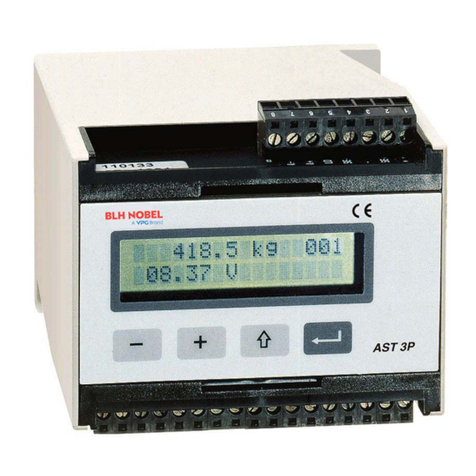
5
SECTION 5. Calibration Procedure
The PS1010T transmitter provides both current and voltage output simultaneously; however
the transmitter can only be calibrated for one output at a time. The zero and full scale
calibration of the transmitter are accomplished via the transmitter front panel ZERO “+”, “-“
and GAIN “+”, “-“ push buttons, and the transmitter status LED. The following procedure is
recommended for proper calibration of the transmitter.
5.1 Procedure
• Connect the PS1010T transmitter as shown in Figure 1.
• Apply power to the transmitter and check for the transmitter’s green LED.
• Connect analog output to voltage or current meter.
• Apply the load cell “zero” input signal and press ZERO “+” or ZERO “-“ until zero
output signal is adjusted. If the signal output is outside normal range and does not
respond to the ZERO buttons, press both buttons GAIN “+” and GAIN “-“
simultaneously to set lowest gain. Continue to adjust zero by pressing ZERO “+” or
ZERO “-“ until the transmitter output signal is adjusted to zero output level.
• Apply the load cell “full-scale” input signal and press GAIN “+” or GAIN “-“ until the
transmitter output signal is adjusted to full-scale output level.
• When transmitter output signals (low and high levels) are satisfied, push
simultaneously the GAIN “+” and ZERO “+” to save the calibration data in non-volatile
memory.
•Calibration is completed. If you want to interrupt the calibration process, do not
perform the save command. You can always recall the last saved calibration data by
pressing simultaneously the GAIN “-“ and ZERO “-“ or power down and up the unit.
Notes:
• Note that every time a calibration push-button is pressed, the yellow LED is turned
on.
• If the push-button is pressed one time, it causes the transmitter output signal to
increment or decrement by small amount. If a large amount of signal change in
output signal is required, then press and hold down the pushbutton accordingly.
• After a dual button command the functionality of the buttons are inhibited for 10
seconds. Release the buttons within this time in order to correctly save or recall
calibration data.
• The end to end gain adjustment time is <1.5 min. At any gain, the time to adjust the
output signal from 0 to 10 V (or 4 to 20 mA) is < 1 min. If the maximum gain is applied
(then <1 min is the time to balance 0.2mV/V referred to input), the time to balance
2mV/V can be up to 10 minutes. To avoid this delay then go to next bullet.
• If the two gain buttons are pushed (GAIN “-“ and “+”), the lowest gain is applied. This
is useful to find the signal and save calibration time.
• If the two zero buttons (Zero “-“ and “+”) are pushed, ‘zero’ balance is achieved at the
unit output (assuming the input is set to 0 V).
Caution: Do not insert sharp or oversized objects into the push-button switch openings as
this may damage the unit. When depressing the push-buttons, use a blunt tipped object and
apply pressure gradually until you see the yellow LED lit up.





























